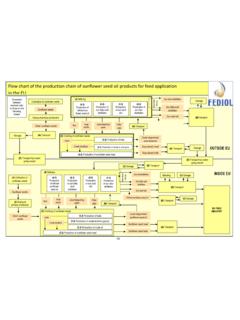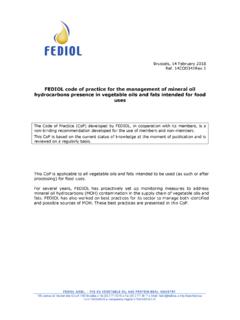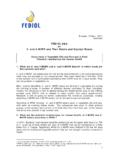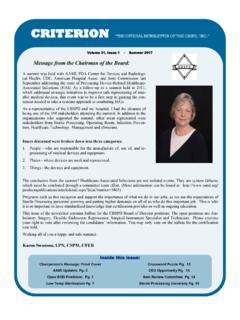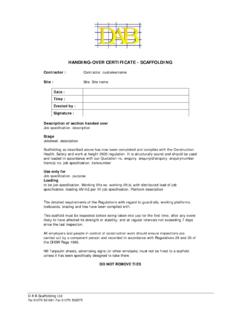Transcription of Table of Contents - FEDIOL
1 24 June 2015 Ref. 15 SAF108 F E D I O L A I S B L - T H E E U V E G E T A B L E O I L A N D P R O T E I N M E A L I N D U S T R Y 168, avenue de Tervuren (bte 12) B 1150 Bruxelles Tel (32) 2 771 53 30 Fax (32) 2 771 38 17 Email : Ets n 0843946520 Transparency Register n 85076002321-31 MCPD ESTERS AND GLYCIDYL ESTERS Review of mitigation measures Revision 2015 Table of Contents 1. Background .. 2 2. Purpose and limitations of the document .. 2 3. Formation of 3-MCPD Esters (3-MCPDE) and Glycidyl Esters (GE) .. 3 4. Methods of Analysis .. 3 5. Vegetable Oil and Fat Refining in Europe: a Snapshot .. 4 6. Refining Processes .. 4 7. Towards Mitigation Measures within the Refining Processes .. 7 Measures applicable to 3-MCPD Esters Measures applicable to Glycidyl Esters 8.
2 Other measures after the Refining .. 16 9. Conclusions .. 17 24 June 2015 14 SAF007 2 1. Background In 2007, the presence of esters of 3-monochloropropane-1,2-diol (3-MCPD Esters) was reported in a number of foodstuffs, including refined vegetable oils and fats. Free 3-MCPD was already known as a process contaminant formed during acid hydrolysis of vegetable proteins (including during the production of soya sauce) and a Tolerable Daily Intake (TDI) of 2 g/kg body weight had been set by the Joint FAO/WHO Expert Committee on Food Additives (JECFA). 3-MCPD Esters are compounds formed during the processing and refining of vegetable oils and fats. 3-MCPD Esters have been shown to have a similar toxicological profile as 3-MCPD.
3 Little is known on toxicological profile of 2-MCPD Esters, but current data show that 2-MCPD Esters are correlated with 3-MCPD Esters. It is anticipated that measures on 3-MCPD Esters will also have the same effects on 2-MCPD Esters. Glycidyl Esters (GE) are found in all foods that contain refined vegetable oils and fats in their recipes. No regulatory levels have been set. FEDIOL members have been engaged in research aimed at identifying mitigation practices or technologies to prevent, reduce or remove 3-MCPD Esters and Glycidyl Esters in refined vegetable oils and fats. Over the last two years, this work has given rise to a large number of new processes and practices with beneficial impact on 3-MCPD Esters/Glycidyl Esters formation and to technological process innovations.
4 2. Purpose and limitations of the document The purpose of this document is to describe the refining process, identify critical areas with regard to 3-MCPD Esters and Glycidyl Esters formation; and to provide information on credible mitigation techniques known to date and available in published literature for the prevention and reduction of these compounds. It also lists the existing mitigation techniques which can be applied today, as they are of a practical nature for implementation on an industrial scale. Refineries differ significantly in their design and processes. Therefore, there is not a one-size-fits-all solution. This document describes a range of mitigation techniques that could be used in combination in order to tailor a refinery-specific solution. Given the various combinations of mitigation techniques which can be applied, it is difficult in practice to give exact figures on the achievable reduction levels.
5 Depending on the applied methods, the type of raw materials, the types of oils and fats, the type of factory and whether 3-MCPD Esters or Glycidyl Esters are present, different levels of reduction can result from the application of the mitigation measures mentioned here. However, their applicability has to be balanced with other factors and limitations as also described in this document. 3-MCPD Esters and GE mitigation continues to be a high priority for the industry; accordingly, new techniques continue to be developed. Therefore, this document will require periodic review and update to ensure it reflects the latest developments in this area. 24 June 2015 14 SAF007 3 3. Formation of 3-MCPD Esters (3-MCPDE) and Glycidyl Esters (GE) 3-MCPD Esters are compounds formed during the processing and refining of vegetable oils and fats.
6 Their occurrence in foods and food ingredients received a particular attention in 2007. They have especially been found in refined vegetable oils and fats, and manufactured products containing such oils and fats. Glycidyl Esters are another class of compound formed during the processing and refining of vegetable oils and fats. They are found in all foods that contain refined vegetable oils and fats in their recipes. Progress has been made to identify the exact formation mechanisms of 3-MCPD Esters and Glycidyl Esters in order ultimately to identify the most appropriate mitigation measures. However, further work is still required since different conditions and criteria seem to interact. Experience built over past years suggests that mitigation of 3-MCPD Esters should focus on the elimination of their precursors, chlorinated compounds, prior to deodorization step, while mitigation of Glycidyl Esters offers a wider range of effective options, prior, during or post deodorization.
7 4. Methods of Analysis In recent years, huge efforts have been made in developing and assessing analytical methodologies for the detection and measurement of 3-MCPD Esters and Glycidyl Esters in vegetable oils and fats in order to find appropriate and reliable analytical techniques. As a result of this intensive effort, three indirect methods developed by the German Society of Oils and Fats (DGF)1, SGS2 and Unilever3 have been available since 2013 for the analysis of 3-MCPD Esters and Glycidyl Esters in vegetable oils and fats. These methods perform well as recently demonstrated by the inter-laboratory comparison study organized by the Joint Research Center (JRC)/ Institute for Reference Materials and Measurements (IRMM)4 and by the international collaborative study conducted by the American Oil Chemists Society (AOCS).
8 Based on the latter study, these three methods have been adopted as AOCS Official Methods5. So far, the only validated available methods, as described above, are based on indirect assessment of 3-MCPD Esters and Glycidyl Esters (indirect methods). In practice, indirect methods mean that the esters are quantified after their conversion to the free form and reported as the sum of 3-MCPD or glycidol. Direct methods mean that the individual esters are quantified without any chemical transformation. For more complex food products, the Joint Research Center (JRC) developed methods for the analysis of MCPD (both in free and esters form) and Glycidyl Esters in various food matrices, details of which were published in March 20156. 1 DGF Standard Methods, C-VI 18 (10).
9 2 Kuhlmann, Eur. J. Lipid Sci. Technol. 113, 335-344 (2011). 3 Ermacora & Hrncirik, J. Am. Oil. Chem. Soc., 90, 1-8 (2013). 4 5 6 Thomas Wenzl, Vasilios Samaras, Anupam Giri, Gerhard Buttinger, Lubomir Karasek, Zuzana Zelinkova, 2015. Development and validation of analytical methods for the analysis of 3-MCPD (both in free and ester form) and glycidyl esters in various food matrices and performance of an ad-hoc survey on specific food groups in support to a scientific opinion on comprehensive risk assessment on the presence of 3-MCPD and glycidyl esters in food. EFSA supporting publication 2015: EN-779, 78 pp. 24 June 2015 14 SAF007 4 5. Vegetable Oil and Fat Refining in Europe: a Snapshot In 2012 Europe s vegetable oil and fat refining industry processed about 7 million tons of crude vegetable oils from oilseeds that were crushed in Europe, essentially rapeseed, sunflower seed and soybeans (so called soft oils ).
10 Furthermore, nearly 6 million tons of crude tropical oils, including palm oil, palm kernel oil and coconut oil, were also refined in European based refineries. Throughout Europe, we estimate that there are about 100 plants, owned by approximately 60 companies, which are refining soft oils and/or tropical oils. The vegetable oil and fat refining sector is relatively concentrated and the number of players is limited. At EU level, the sector is represented by FEDIOL and the association captures about 90% of the refining volume. 6. Refining Processes Flowcharts Physical Refining Chemical Refining Crude Oil Degumming Neutralization Bleaching Deodorizing Refined Oil Crude Oil Degumming Deodorizing Bleaching Refined oil 24 June 2015 14 SAF007 5 Refining Process: Step Description Step Process Description Refining Crude Feedstock There is a wide variety of seed, nut and fruit oils and fats that are refined to produce bland, odourless, fit-for-purpose products that meet both customer and food safety and quality requirements.
